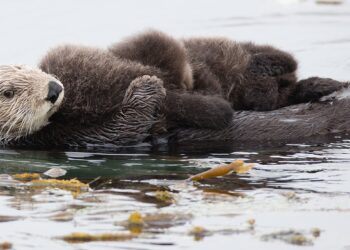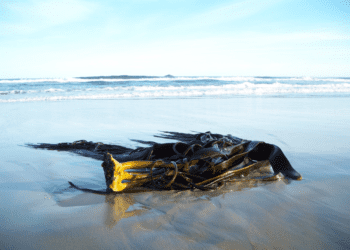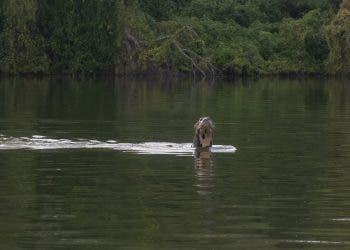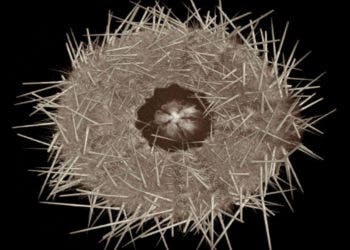Kelp forests around the California coast have declined dramatically in recent years. Attacked by urchins, heat, and left without the defense of sea stars, kelp has fallen by up to 95% in some areas, leaving large swaths of “urchin barrens” behind. Even in these conditions, researchers have found, otters can help ensure that the remaining patches of kelp stay healthy.
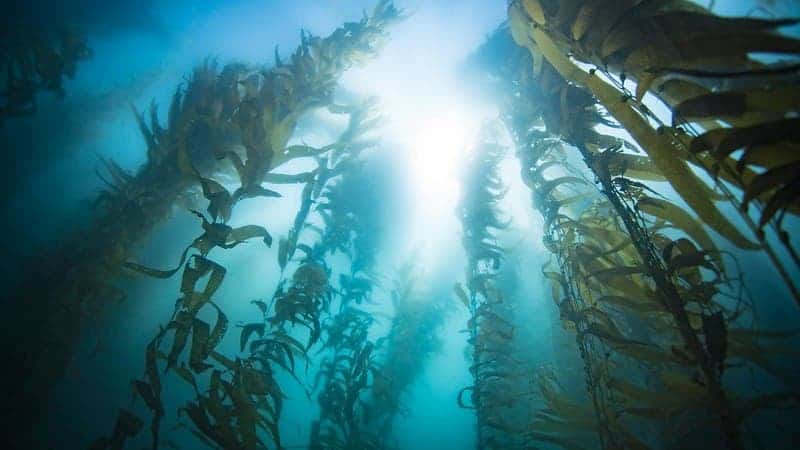
It all starts with kelp. Kelp is an umbrella term for a group of large brown algae that grow in “underwater forests” (kelp forests) in shallow oceans. They harbor rich ecosystems and can grow quite fast and reach impressive heights. Up to a few years ago, this is exactly what was seen off the coast of California.
“I’ve been diving here in this ecosystem since 2012 and back then, things looked very different,” UC Santa Cruz graduate student Joshua Smith, lead author of the study, explains in an interview. “We had these kelp forests that were so dense that being underwater was like walking through a redwood forest. Back then, I remember some times when the kelp canopy — the top part of the kelp that’s made its way all the way to the surface of the ocean — was so dense, that we couldn’t even get a boat into the place where we needed to do our science. There were just hundreds of meters of kelp extending offshore.”
But then, in 2013, things started to change. Despite its ability to grow, kelp is vulnerable to overgrazing by sea urchins. Normally, sea urchins are themselves kept in check by sea stars, but around 2013, a mysterious disease called sea star wasting syndrome started to decimate the starfish population.
“Around 2013, I was diving in this area and I started to notice that the sea stars had these lesions,” Smith continues. “And before we even knew what was going on, these sea stars dissolved, they were being hit by this wasting syndrome.”
It didn’t take long for the sea urchins to figure out what was going on. Normally, they spend their time in crevices where they’re hiding from predators and eating drift kelp, kind of like leaves falling from a tree. But after the sea star wasting event, the urchins were emboldened. They started going out and actively grazing on the remaining kelp until they ate it all.
That’s when the otters came in.
“Sea otters haven’t been seen on the North Coast since the 1800s,” said Meredith McPherson, a graduate student in ocean science at UC Santa Cruz, and author of a separate study on California kelp forests. “From what we observed in the satellite data from the last 35 years, the kelp had been doing well without sea otters as long as we still had sunflower stars. Once they were gone, there were no urchin predators left in the system.”
Empty boxes of pizza
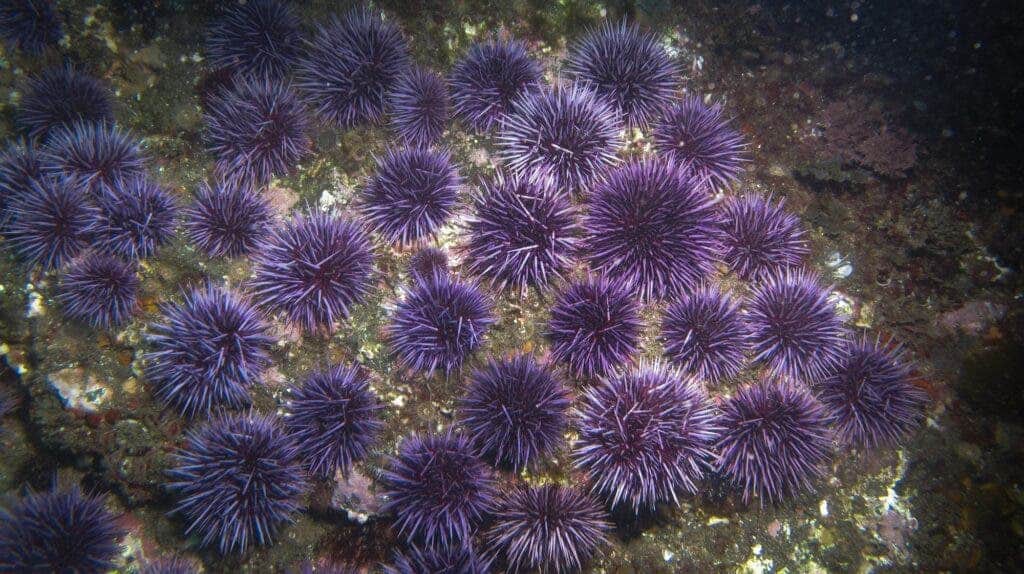
Climate dealt the finishing blow to kelp. The 2014 marine heatwave called “the blob” made the underwater forests more vulnerable and hampered their growth.
“And so as a diver, I remember seeing all of these events unfold,” Smith recalls. “Then finally, in 2017, when we spun up this study, the region had already kind of shifted from that really dense, lush kelp forests to this patchy mosaic of kelp forests interspersed with sea urchin barrens.”
“It happened so fast, before we knew it we had lost over 80 percent of the historic kelp forest cover in Northern California,” Smith said. “We also had an urchin outbreak on the Central Coast, but not to the same extent as in the areas north of San Francisco.”
By then, otters had already become very active in the area. Smith and colleagues had been keeping an eye on otters, who also like to munch on sea urchins. They found that after 2014, otters were eating three times more urchins than they had before — but not from the barrens. Otters were careful and focusing on urchins within remaining kelp forests, skipping those in the barrens.

Eager to understand why this is, divers surveyed those places not targeted by otters and collected urchins to examine in the lab. They found that urchins in the barrens have far fewer nutrients than those in healthy kelp forests. For the otter, the barren urchins are just not worth it.
“The sea otters prefer to eat those healthy, nutritionally valuable sea urchins that are in patches of kelp forests and they mostly ignore those that are in the barrens that are completely starved out,” says Smith.
It’s a bit like buying a pizza from a nearby shop, Smith explains, and getting an empty box. At first, you’d be confused, and perhaps get another pizza. But if the second one also comes up empty, you’d probably opt for a different pizza shop, even if it’s farther away — this is what’s happening to the otters. They quickly realized that barren urchins are no good for them and so they opt for the healthier urchins, even if it means traveling a greater distance.
Sea deserts
This is good on one hand because it means that it’s helping remaining forests stay healthy and not become barrens. But on the other hand, this means that urchin barrens will continue to remain barren.
It’s different than in other ecosystems. If overgrazing were to happen on land, say if deer were to overgraze grasslands or shrublands, they would starve. But in the case of the urchins, that doesn’t really happen. Urchins can survive for years even being starved out. They can eat microorganisms living on the reef, or even scrape the reef itself for other types of algae. Even once all these food sources are depleted, they can still survive for a long time by slowing down their metabolism to a state of dormancy.

“Urchins can persist and survive and a starved state for a really long time. We’re talking several years. So when urchins overgraze kelp forests and transform for us to these underwater deserts that we call sea urchin barrens there’s no more food available for them or, or very little food,” Smith adds.
This is also why they’re so unappealing to otters: the urchins are starving themselves and have little that’s of interest to a predator.
That’s part of what makes these sea urchin barrens so tricky. They’re like environmental deserts, and the only way to change that is by bringing kelp back into the mix. But the moment kelp comes back in, the urchins will just devour it down to nothing — and predators like otters have little interest in these urchins.
But there are ways to get rid of an urchin barren.
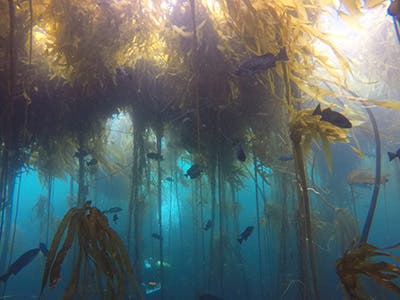
While it hasn’t happened in the California area, urchins can contract devastating diseases that could quickly wipe out large parts of their population. Wind is another mechanism to dislodge urchins: large waves could physically swipe urchins off the reef. The third mechanism is predation.
“It’s clear that the otters are not foraging on urchins in the barrens, however, there could be other animals that would target urchin barrens. It’s possible that if and when the sunflower stars recover, they may be able to reduce the number of urchins in these barrens,” Smith adds.
In addition to those things, Smith notes, there are a number of pilot studies looking to see how effective urchin cleaning is. In some areas, especially in northern California, the state has approved divers to go out and remove the urchins themselves. There’s also one organization called California Reef Check which mobilizes members of the community to engage in science and survey these areas.
“The purpose of those pilot studies is twofold. Number one is to see if this is something that could actually be done by the local community. Can humans go in the water and remove enough urchins to make a difference? And then the second part of it is the science side, which is being charged by California Reef Check. And so they are going out and doing the monitoring of those locations where the urchins are being eliminated to see what happens once their numbers are reduced. Does that help the kelp come back? They’re the ones who are actually tracking all of those things.”
The study has been published in Proceedings of the National Academy of Sciences.
